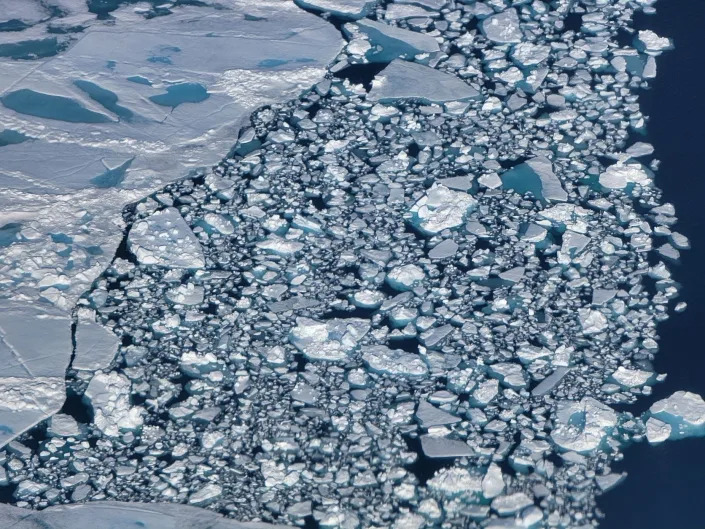The Staunton News Leader
We created scorching ‘heat islands’ in East Coast cities. Now they’re becoming unlivable
Joyce Chu, Eduardo Cuevas and Ricardo Kaulessar – July 27, 2022
Thelma Mays couldn’t breathe.
On a blazing summer day, she began gasping for air inside her Petersburg, Virginia, apartment, and was forced to call 911. If she’d been able to look out her window to see the ambulance pull up at Carriage House, an income-based complex for the elderly, she wouldn’t have been able to see a single tree. Just the other side of the sprawling brick building.
She lives on the edge of a type of “heat island,” with wide stretches of concrete that bake in the sun and retain heat. She turns on the air conditioner when her room gets unbearably stuffy, which may have been the cause of her sudden coughing spasm.

When it is too hot to go outside on city streets, the indoors can be just as dangerous for her lung condition, if she gulps refrigerated air for a precious few minutes in front of the AC vent. Mays, 78, has chronic obstructive pulmonary disease, and a quick shift in humidity or temperature can trigger a respiratory emergency.
These days in central Virginia, trapped on the edge of a hotter-than-normal part of an often-overlooked majority Black city, escalating heat and weather patterns are putting Mays and others under health and financial stress. It’s pressure not yet being felt equally in wealthier, majority white suburban areas of the state with landscaped gardens and plentiful indoor cool spaces.
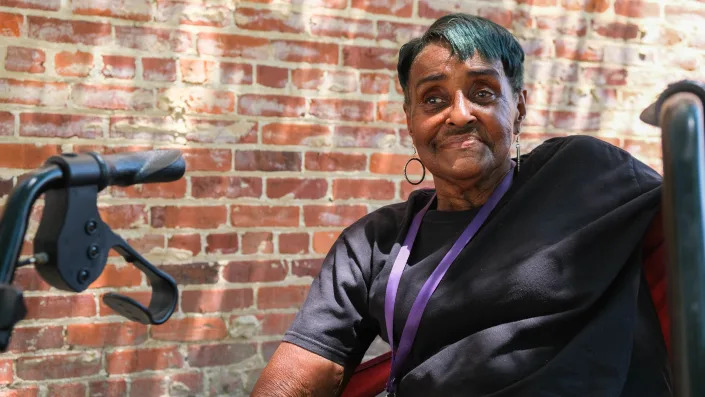
Graphics:Record-high temperatures from heat dome affect millions
Mays was transported to the emergency room that day.
Doctors worked for hours to stabilize her breathing, giving her IV steroids to help her lungs function.
Stranded on an urban heat island, many don’t survive
The Carriage House apartment complex has a few small trees by the sidewalk, none big enough to provide cover for a single person.
By contrast, Walnut Hill — one of the wealthiest and most tree-lined parts of the city — was more than 13 degrees cooler in the shade. Large trees create an arching canopy over the streets. Nearly every house has wide lawns skirted by mature shade-providing trees. Even in the sun, it was 6 degrees cooler than in Old Towne.
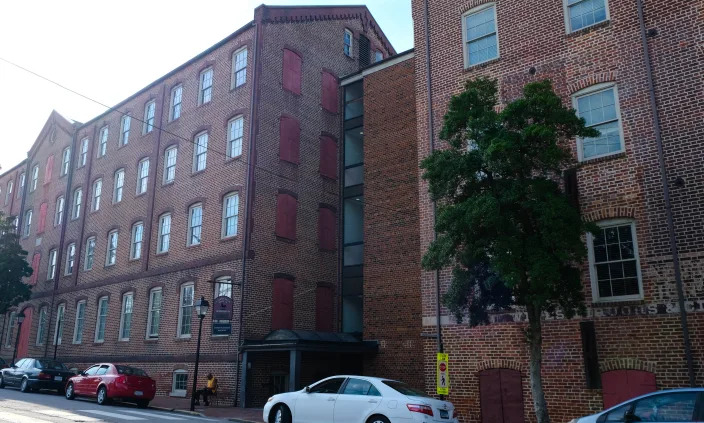
Old Towne is the hottest area in Petersburg based on 2021 heat-mapping.
Even on hot days, Mays uses her walker to reach the other side of the street where she can sit under the shade of a couple of small trees by a parking lot. She hates being cooped up in her apartment.
Blocks of shops and long treeless stretches of asphalt and concrete trap the heat in Old Towne. On a sweltering July afternoon, we recorded field temperatures at a scorching 101 degrees. Unlike in the West, this level of heat on the East Coast is often accompanied by moisture in the air.

What to know about the impactUrban heat islands are why it can feel 20 degrees hotter in different parts of the same city
“When you have very high humidity, your body can’t evaporate your sweat off of your skin,” said Jeremy Hoffman, the David and Jane Cohn Scientist at the Science Museum of Virginia. “It’s very difficult to cool off naturally. You really need additional help.”
Everything you need to know about heat:From the heat index to a heat dome to an excessive heat warning
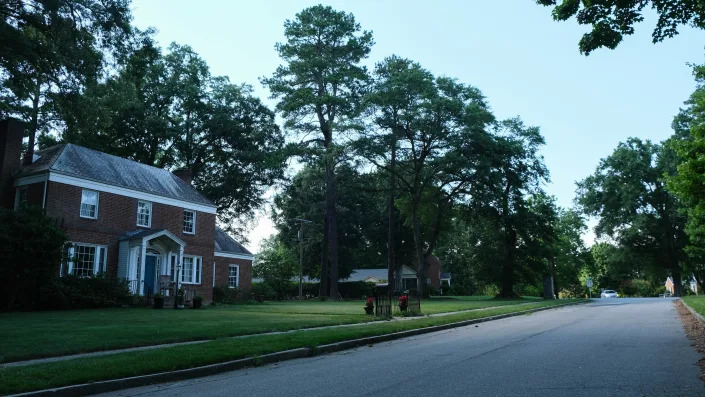
A difference of a few degrees in extreme heat can affect the body’s ability to regulate its temperature. Some emergency rooms will put out extra gurneys in anticipation of more patients who’ll come in with syncope, respiratory illnesses or heart failure.
Thelma Mays recovered and her granddaughter drove her home. Others in her situation are not so lucky.
Heat death in East Coast cities
We looked at heat islands during an extensive USA TODAY Network reporting project called “Perilous Course,” a collaborative examination of how people up and down the East Coast are grappling with the climate crisis. Journalists from more than 30 newsrooms from New Hampshire to Florida are speaking with regular people about real-life impacts, digging into the science and investigating government response, or lack of it.
Death on a heat island is not as visible or cinematic as the dramatic images of homes crushed by a hurricane, belongings washed away and trees bent by the wind. The elderly and young children fall victim to excessive heat in their homes or inside of cars, away from the public eye and the flashy news headlines.
Hurricanes are short-lived phenomena which are often predicted weeks in advance. Heat’s different. It can come as a heat wave, which can last for days and have no set, predictable spatial boundaries. It enhances conditions on the ground which absorb the heat.
About that dire climate report:We have the tools we need to fix things
“A heat wave is very hard to define in space and time,” said Hoffman. “It’s not something that you can see on the map; it is something that you feel in the outdoors. So, we have a crisis of communication around heat.”
Climate change has exacerbated the intensity of heat waves, the number of excessive heat days per year and the length of these heat waves. The average length of a heat wave season in 50 big cities studied is now around 70 days, compared to 20 days back in the 1960s. In less than one lifetime, the heat wave season has tripled.
In some places, summer can feel like one long heat wave.
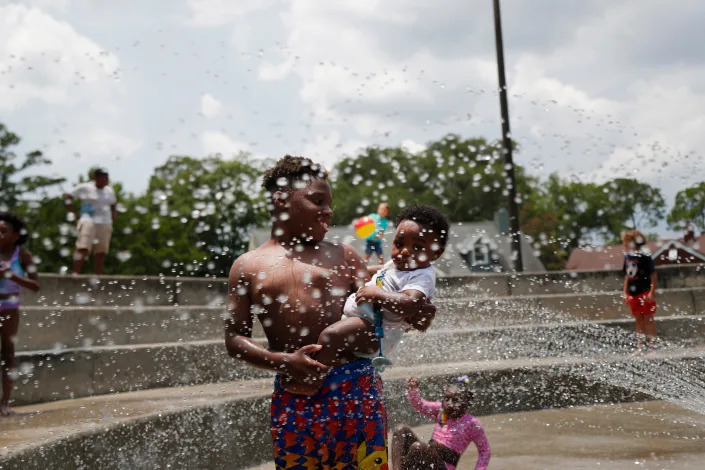
The warming climate has been tied to increased mortality around the world. In a large-scale study that examined heat in 43 countries, including the U.S., researchers found that 37 percent of heat-related deaths could be attributed to the climate crisis.
Extreme heat can be more dangerous for those in the Northeastern United States.
“What becomes really dangerous in these more northern cities is that they haven’t yet adopted air conditioning very widely yet,” Hoffman said. “And especially in lower income and communities of color or immigrant communities, prevalence of air conditioning utilization is very low.”
Three of the country’s nine least-air-conditioned cities are in the Northeastern states — Providence, Rhode Island; Hartford, Connecticut; and Buffalo, New York, according to U.S. Census bureau data and a USA TODAY report.
‘Code Red’ Heat:The climate emergency is sending more kids of color to the emergency room
In Florida, researchers have been measuring the impact of heat islands.
The National Oceanic and Atmospheric Administration has conducted studies in West Palm Beach and Jacksonville, sometimes using volunteers to capture data. Its studies have indicated that low-income neighborhoods in Florida have less ability to cope with the damaging results of manmade heat islands.
A nonprofit research group called Climate Central found that Jacksonville’s heat island was potentially raising the overall average temperature of the entire city by as much as 6 degrees.
The “feels like” temperature or heat index can make a major difference for people living in humid places like Florida.
On 58th Street in West Palm Beach on a block barren of shade trees it reached 93.9 degrees near noon on July 22 with a relative humidity of 58%. That means it felt like 106 degrees.
“My electric bill was almost two-fold in June from what it was in March,” said 27-year-old Varun Parshad. “I try to be more disciplined with the temperature settings.”
Six miles to the southwest, the National Weather Service’s official gauge at Palm Beach International Airport registered 88 degrees with a lower feels-like temperature of 100 degrees.
The difference between 58th Street and the airport is significant enough when meteorologists and emergency officials have to make heat-related decisions, and it’s something some cities are recognizing as they plan for a warmer future.
No matter what part of the East Coast you’re in, things are getting hotter and more dangerous.
Extreme heat affects low-income communities and people of color on a greater scale due to structural inequities. From 2005 to 2015, the number of emergency room visits increased by 67% for Black people, 63% for Hispanic people and 53% for Asian Americans, compared to 27% for whites.
The conditions for heat to become deadly in certain places were set into motion decades ago by people who were very aware of race. As Hoffman himself would discover, those intentional decisions led to unintentional consequences in the present.
Discrimination made East Coast neighborhoods worse
In Petersburg, to the west of Thelma Mays’ apartment, there is an empty lot that dates back to colonial America and has housed a trading post, tobacco stemmery and Civil War prison in a town that had the highest percentage of African Americans of any in the Confederacy.
The block that remains has grass and some shady trees, and money has been spent on history signage and the stabilization of a crumbling wall. But there are not municipal improvements that give anyone who lives nearby many options to sit and use the shady space during the suffocating summer.
Hundreds of miles north from Thelma Mays’ apartment, there’s another woman who can’t stay indoors when the sun comes up in summer.
Several streets in Brianna Rodriguez’s Nodine Hill neighborhood in Yonkers, New York, are named for trees. But few trees actually line the sidewalks, and there aren’t many parks.

“I couldn’t just stay in my room,” she said about the July 4 holiday weekend. Unable to afford AC units, Rodriguez’s family goes outside instead, to try to find a park to cool off.
When they have to be inside, three industrial fans normally used to quickly dry paint circulate air toward the center of Rodriguez’s living room in Yonkers. But even on full blast, they can’t cool the 18-year-old, her mom, stepdad and their dog inside their third-floor apartment.
There isn’t much shade throughout the working-class Black and Latino neighborhood. Rodriguez avoids certain streets she knows would be too hot between rows of taller apartment buildings and scalding pavement and asphalt.
The new normal:People haven’t just made the planet hotter. We’ve changed the way it rains.
The characteristics of the neighborhood Rodriguez lives in — residential areas with little or no parks or tree-shade, often bordered by industrial areas, warehouses or bisected by highways and overpasses — are the material remnants of an economic rating system nearly a hundred years old that disincentivized mortgage loans and devalued property.
The creation of “undesirable” economic districts by the government and banks isolated parts of the city populated by non-white people. Those “redlined districts” and the neglect of those areas that followed created the conditions which studies are now proving to be dangerous for human health amid the climate crisis that has already arrived.
Maps of city heat islands are a deadly mirror of redlined neighborhoods
In July 2017, Jeremy Hoffman set out to map Richmond, Virginia, using a new heat-tracking methodology developed by his colleague Vivek Shandas.
Someone told Hoffman that his heat map looked a lot like a map of Richmond’s redlined districts, which Hoffman didn’t know much about at that time. When he compared them, they looked almost identical.
He went to Baltimore, Boston and Washington, D.C., to gather temperatures. The results of the heat maps again matched up with the redlined maps of each city.
That next summer, Hoffman gathered surface temperatures through satellite imaging in each of the 250 redlined cities to see if the heat islands correlated with previously redlined areas, available through historical maps.
The pattern repeated itself in virtually every redlined city across America. Hoffman found redlined areas were on average 4.7 degrees hotter than greenlined areas of the same city.
His team was the first to compare heat and redline maps on a nationwide scale.
When Hoffman started the research, some scientists in his circle were skeptical. Was he looking at heat-mapping through a racial lens?
What he saw was the consequence of historical human decisions which themselves were racial in nature. Which areas should get investment? Or parks? And which areas could be sacrificed to have freeways built through existing neighborhoods?
“Cities don’t happen by accident,” Hoffman said. “Our neighborhoods don’t happen by accident. Everything is a decision that’s been made. Every single second of your daily life in a city is the integrated outcome of all the historical planning policies and decisions that were made before that.”

A harsh but telling example: Maps made by the Home Owners’ Loan Corporation described Nodine Hill, then heavily Italian, as “hazardous,” a September 1937 form said. Its detrimental influences, the form said, were aging buildings and the “character of occupants.”
On average, a person of color lives in a census tract with higher surface urban heat island intensity than non-Hispanic white people in all but six of the 175 largest urbanized areas in the U.S., according to a 2021 study published in the science journal Nature Communications.
‘By design or neglect’Flood, climate hazards threaten Massachusett’s redlined neighborhoods
Black residents had the most exposure to heat islands, researchers said, followed by Hispanic people.
The underlying conditions for heat islands were set decades ago by the economic isolation of redlining. Climate change just catalyzed these places to make them even more dangerous to human life.
Absorbing the history of heat
As a young child, Rodriguez didn’t play on the swings at her Nodine Hill elementary school on the hottest days, though they were her favorite part of the playground.
At recess, she skirted School 23’s playground, built on a black rubber mat over concrete, and joined hundreds of students huddled under a few trees. The sun glared directly down on the swings’ metal links, making them too hot to hold onto.
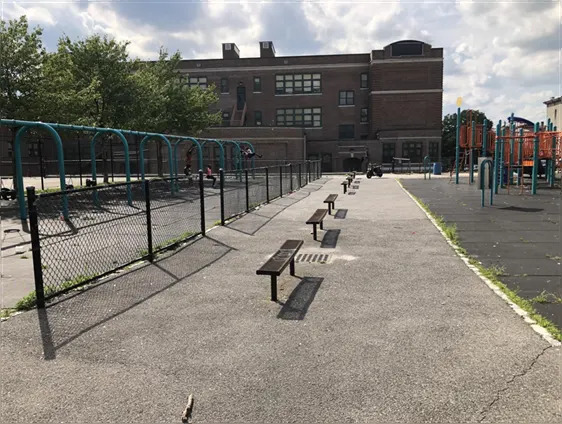
“I had always felt that it was hotter,” Rodriguez said on a recent Friday afternoon in the shadow of her old school, a large brick building for pre-K-8 students built in 1918. “It was just evident to me.”
Temperatures were in the 90s on July 1, 2022. But Rodriguez felt it was even hotter in Nodine Hill. The neighborhood is just a mile uphill from the Hudson River, which provides daily breeze for those along the water.
School 23’s playground was nearly empty a week after classes ended. A few teens sat by one of the basketball hoops in the shade. Rodriguez’s gold necklace with her middle name, Brooklyn, glinted in the sun.
On hot days, without shade or greenspace that can cool neighborhoods, fewer people are outside in Southwest Yonkers. Instead, many cluster indoors to keep cool.
The Civil Rights Act’s eighth provision, the Fair Housing Act, ended redlining in 1968. But previously redlined areas remain low-income and overwhelmingly non-white.
Upscale neighborhoods are edged with trees and parks with shaded pathways. In Southwest Yonkers, where Nodine Hill is located, residential areas are edged with unwanted facilities, congested roadways, sewage and wastewater treatment plants, according to Brigitte Griswold, executive director of Groundwork Hudson Valley, an environmental justice nonprofit that’s studied the local effects of redlining.
Resulting air pollution contributes to higher rates of asthma and heart disease in these communities, she added.
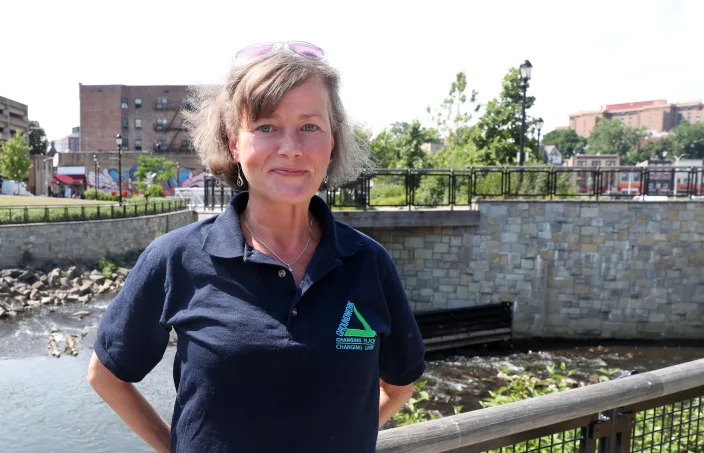
Griswold said the self-imposed isolation impedes people from checking on each other during a heat wave.
“It’s kind of a double-edged sword,” she said. “The heat itself prevents that social cohesion from happening. And then that breaks down community resilience to respond to the very thing that is driving people apart.”
Growing development brings more heat
The little growth that has come from the end of redlining is not always welcome or healthy. In these spaces, where land is cheaper and zoning fluid, manufacturing sites, energy plants and big box stores have sprung up.
New Jersey resident Tanisha Garner knows more buildings in her neighborhood mean more heat.
Garner, a Newark native who has lived in an area called the Ironbound for the past four years, said at least 10 projects are being planned for the area — and that they will be built with materials that absorb and radiate heat.

The Ironbound area got its name from the metalworking factories and railroad tracks in the area. For over a hundred years, this eastern section of Newark was home to all kinds of industrial activity. It was also an area redlined back in the late 1930s, classified as “dangerous” and marked by the federal government to be excluded from mortgage eligibility.
Many of those industries are long gone. Others have taken their place. A waste-to-energy incinerator, a sewage treatment plant, a metal plating shop and numerous warehouses. The area has been subject to some of the worst pollution in the state.
Garner thinks these development projects take out greenery and open space and fill them with buildings that help amplify the heat in her neighborhood.
“What creates that heat island? Is it the structure of the building, is it a lack of trees, is it the lack of balance between nature and construction?” Garner said. “When you look at the Ironbound, you can see there is an imbalance.”
During a tour of her neighborhood in July, Garner pointed out some of the areas designated for development.

One of those areas encompasses Freeman and Ferry streets, the future site of a six-story, 280-unit complex to be built at the site of the historic Ballantine Brewery, starting this summer. The current area has no trees lining the sidewalk. A rendering of the proposed project shows numerous trees surrounding the building. Will it be enough to offset the potential heat effect of such a huge structure?
A temperature check of that block at 11:20 a.m. registered 95.7 degrees, six degrees more than the city’s temperature of 89 degrees at that time, according to the website Weather Underground.
Heat island as zombie apocalypse
In July 2020, Brianna Rodriguez took her handheld FLIR thermal camera and pointed the bullseye at School 23’s black rubber mat where she once played. It was 88 degrees in Yonkers that day, she noted. Down on the mat, it was 127 degrees.
The infrared camera captured yellow and orange colors around the mat, signaling more surface heat, as opposed to blue and purple meaning cool.
She jotted the reading down in her journal, as part of Groundwork Hudson Valley’s green team, composed of Yonkers teens interested in sustainability and climate change. They were completing an exercise developed by Shandas, where they pretended the heat was a zombie apocalypse affecting her neighborhood. Where it was yellow and orange on the camera, there were more zombies.
The image of her playground looked like the surface of the sun.
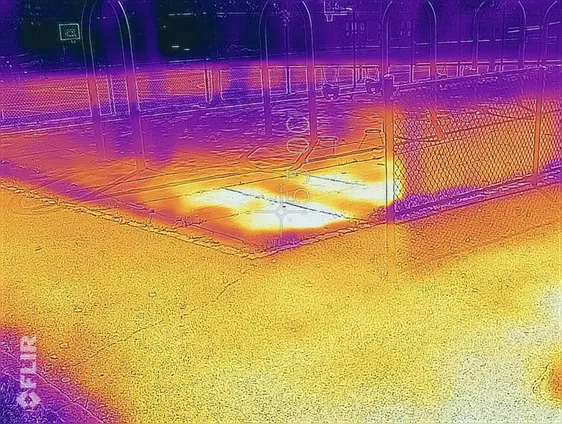
Ultimately, potential solutions for minimizing the deaths from heat islands should be a lot easier than protecting a city from zombies. Shandas, a chronicler of the “heat dome” phenomenon that settled over Portland, Oregon, with deadly results in its hottest neighborhoods last summer, said immediate action can be taken with lifesaving results.
- Cities can open more cooling centers during hot days to give residents respite from the heat.
- Property managers can do checks on apartments when indoor temperatures soar above 90 degrees.
- Planting trees in heat islands can also have an immediate impact that will only grow as increasing canopy creates more shaded area, while adding oxygen to the local atmosphere.
Such changes, Shandas said, can be implemented ahead of more complex structural changes to amend building codes for cooler buildings with walls or roof construction materials that deflect heat.
Tree planting programs have been implemented in many states. But where the trees are planted matters. While thousands of trees have been planted in Newark in the last several years, the agency in charge would not say how many were planted in the Ironbound. Walking through the Ironbound’s streets, it’s hard to think that this area has been targeted for a tree-based solution.
A few years ago in Rhode Island, a young musician-turned-activist noticed a similar lack of new trees being planted in the least shady neighborhoods in places such as South Providence and Central Falls. Kufa Castro worked with local governments and citizens to make sure that over 190 trees were planted in a two-year period in areas with little tree canopy.
Ultimately, Shandas explained, heat islands are manmade and can be managed.
“It goes back to a lot of conditions that have been created by human decision-making processes,” he said. “What we really want to do is try to figure out what are the ways we can unpack some of this and get ahead of it.”
Down the street from School 23, children took turns running past an open fire hydrant that sprayed water into the middle of the street. Scrambling in a ragged line, they screamed with delight as the cool water hit them. Rodriguez had done the same as a kid.
That night, as fireworks sizzled and boomed overhead, the pavement by the hydrant had long since dried in the heat. The heat of the day, held like a memory by the playground’s metal and rubber matting, slowly released into the night.
— Palm Beach Post reporter Kimberly Miller contributed to this story.
This article originally appeared on Staunton News Leader: City heat islands force vulnerable residents to weather summer’s worst

